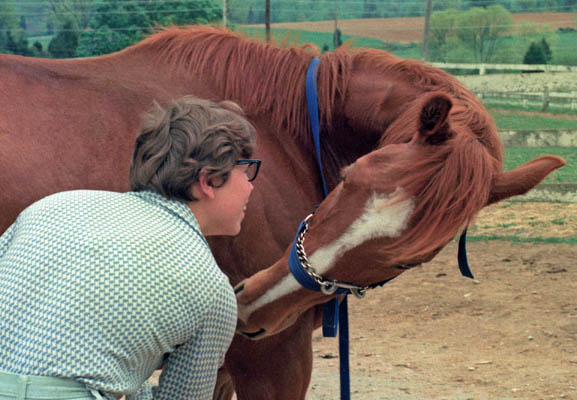So, You Think You Love Horses?
Some Reflections on the Nature of Horses and Man
Glossary of Equestrian Terms
Words Beginning with T
-
Table Jump
[Jumping] A table jump is a flat mound of earth that the horse first jumps up on and then must jump off of.
-
Tack Up
[Horse Management] Tacking up involves all the necessary actions taken to prepare a horse to ride. Included is grooming the horse's coat, picking their feet, securing the saddle pad and saddle, checking the tightness of the girth (often overlooked), bridling and placing any other supplemental tack, as martingales. When it is all done you can let out a breath and mount up. It was so much better when the average lord could have a couple grooms.
-
Tail Bag
[Showing] A tail bag is a cloth bag placed over a show horse's tail after it has been groomed to keep it clean until going in the ring. Their more prolonged use for the general protection of the tail from snags and the like is more controversial. I believe nature intended horses to use their tails against flies and bagging might impede that. We do not want to over-accessorize our mounts afterall.
-
Tail Shot
[Polo] A tail shot is one in which the ball is hit by reaching behind and under the horse's body. It is rather difficult to perform, particularly when done to the nearside, and requires precise timing. The most common polo shot and the one with the least risk of missing is the full-swing, offside, forward one.
-
Takeoff Point
Takeoff Point
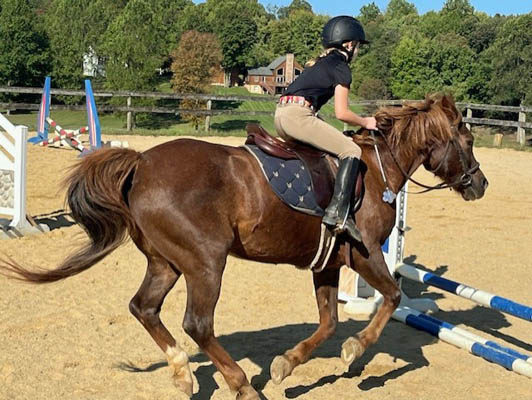
|
[Equestrian Jumping] The takeoff point is the spot in front of the jump where the horse leaves the ground. There is an optimum ranges of distances and problems if going to short (deep) or too long.
-
Tally-Ho
[Fox Chasing] The traditional cry raised when a fox was viewed to alert others riders to the fact. The cry likely comes from the French word talaut originally employed as a huntsman's cry when hunting with deer hounds. However, It should be emphasized that a member of the field should never call tally-ho, but remain quiet and face the direction of the fox and holds out his cap. Only the staff calls tally-ho at the appropriate time.
-
Tandem Hitch
[Driving] A tandem hitch is when two horses are driven one in front of the other rather than side by side.
-
Tanking Off (British Usage)
[Equine Behavior Problem] A horse is said to tank off when under its own volition is moves off in opposition to the will of the rider or handler's effort to control it. This can happen on the ground or with a mounted rider. The situation is somewhat like bolting, but a bolting horse is generally in a panic. A tanking off horse is just having a behavior problem.
-
Tapadero
[Equine Equipage] A tapadero is a thick leather guard placed on the front of western and some military stirrups to both protect the boots and keep them from slipping forwards.
-
Tarpan (Equus ferus ferus)
[Equine Breed] The ancient wild Tarpan breed is now extinct. There are many observational reports of wild horse populations in Europe in prior centuries that might represent sightings of the Tarpan, but some of these may just be populations of escaped domestic horses or hybrids. An effort to recreate a Tarpan-like horse was undertaken and that horse is now referred to as a Tarpan. Maybe in the future good genetic material may come available for study but even that is problematic since their range overlapped with domestic horses.
-
Team Penning
[Rodeo Event] In team penning teams of three riders compete to remove three specific cows from a herd and drive them to a pen on the opposite side of the ring, preventing the cows from sliding by and rejoining the larger herd. The team with the fastest time wins.
-
Team Roping (Heading and Heeling)
Team Roping
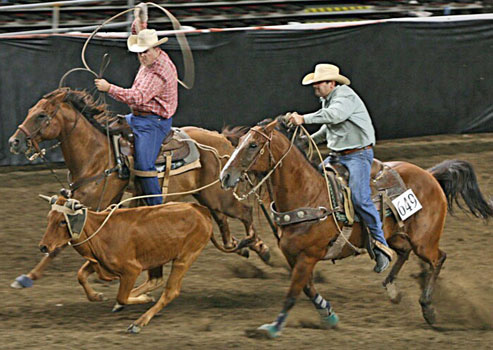
|
[Rodeo Event] In team roping two teams compete to see which of the two rider teams is able to finish roping a steer's head and back legs. One member of the team is the header, who ropes the steer's head and then secures the rope and turns the steer's head to the left. The other rider is the heeler, who ropes the back legs once the header has finished his end. The competition's rules are open to both male or female participation on the same team.
-
Tempi Changes
[Dressage] Tempi changes are sequenced flying (while the horse is in suspension) lead charges that can occur every stride or every so many strides.
-
Ten Minute Box
[Eventing] The ten minute box is a prescribed veterinary check between phases C and D before the horse and rider can proceed.
-
Tennessee Walking Horse (Tennessee Walker)
[Horse Breed] Tennessee Walkers are a 4-gaited horse breed with a unique four-beat running-walk. The now very popular breed did not solidify until the late 19th century and did not become fully established until the early 20th. They are larger than many other gaited horse breeds with a calm disposition and smooth gaits, Those who ride them avoid cantering them and prefer to ride them in their running-walk gait. It can be difficult if you are riding with a walker to keep up with them with another breed in a walk. I found periodically I needed to trot to keep up. The walker I rode would stretch his legs out to assist a rider mounting him.
-
Tent Pegging
[Equestrian Competition] Tent pegging is a competitive event in which a galloping rider, using a sword or a lance, strikes or spears a stake stuck in the ground. The manner in which the game is carried out can vary. It developed from ancient cavalry training exercises. The game is popular in Australia, India, Israel, Oman, Pakistan, South Africa, and the United Kingdom. It is still fairly
unknown in the U.S. and may suffered from having a name that does not seem to connote anything having to do with horses.
-
Terracotta War Horses
A figurine of a Terracotta War Horse Sold to Tourists at the Site
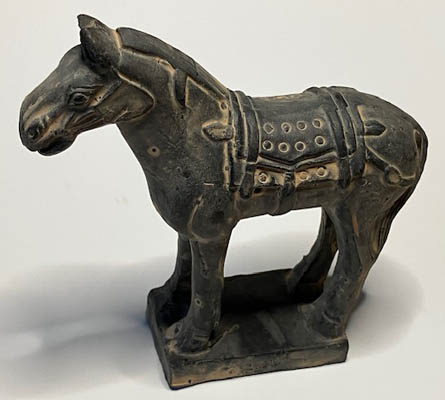
|
[Equestrian Statues] Chinese Emperor Shi Huangdi, who died 210 BCE, constructed one of the the most elaborate tombs known to history. The terracotta warriors are fairly well-known, but there are also terracotta war horses. These horses were originally painted to appear natural, but the paint has decayed over time. Like the warriors they are individually detailed and are both intended as cavalry and chariot horses. There average size is 13 hands, similar to the horses ridden by the step peoples from whom the Chinese acquired their breeding stock. However, the Chinese were unsuccessful in maintaining herds. There are many reasons for this, but the major one is that the fodder they used was nutritionally deficient. Prior to Emperor Shi, horses of great leaders were often sacrificed at their death. This is obviously not a way to build up a herd and the Emperor's terracotta horses were intended as substitutes for the real thing.
-
Terret (Rein Ring)
A Harnessed Horse having Reins Passing through a Terret
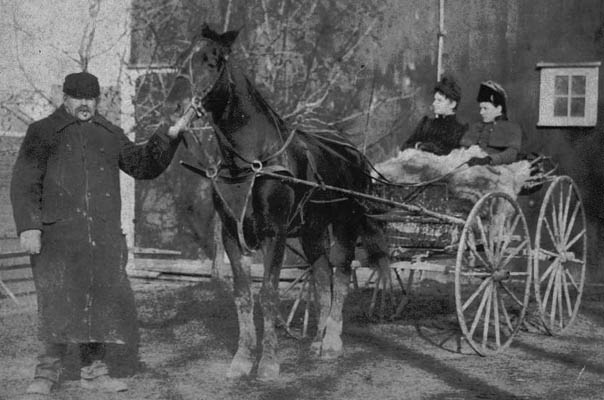
|
[Driving Equipage] Terret are a series of metal rings that carry the reins between the bit and the driver's hands and are set into tack at various points along the route. Their purpose is to keep the reins from sagging, tangling or getting snagged on the harness or shafts.
-
Tetanus
[Veterinary Medicine] Tetanus is a vaccine preventable disease caused by the toxin producing, anaerobic bacterium Clostridium tetanii. These organisms exist in manure and form difficult to kill spores in soil. If a wound occurs the spores may contaminant the wound, germinate and release toxin causing the disease. Proper vaccinations and vaccination of pregnant mares to protect their foals in essential. Humans working with horses should also be current on their own immunizations. The horses environment should be inspected for exposed nails, wire or other sources of injury.
-
Tetrathlon
[Youth Equestrian Event] Tetrathlon are comprised of four phases: human running, target shooting, human swimming and horseback riding. A competitor’s combined scores in all four phases determines their overall placing in the competition and serves to build a well-rounded athlete. The Tetrathlon is a variant of the Pentathlon Olympic Sport, but without fencing. These youth events are sponsored by United States Pony Clubs, Inc..
Textured Horse Feed
Textured Feed
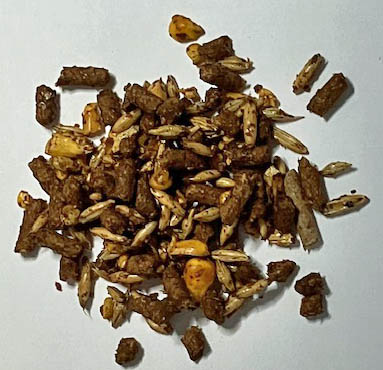
|
[Horse Nutrition] Textured horse feed or sweet feed is a common feed that has been used for a long time. It is a mixture of ingredients, including some pellets, fiber, grains and molasses. Recently the pelleted version of this feed has been gaining in popularity. I find the pellets are easier to handle and did not leave a residue on feed buckles or other containers. Certain horses may prefer one or the other and occasional horse will eat pellets too quickly, causing choking. Dietary starch is higher in textured feed and might be an issue in horses with metabolic issues.
-
Therapeutic Riding
[Medical Treatment] Therapeutic riding an equine-assisted activity for the purpose of contributing to the cognitive, physical, emotional and social wellbeing of patients with special needs. There are certified therapeutic riding instructors, who are accredited through the Professional Association of Therapeutic Horsemanship International. Insurance coverage may be provided in some cases. The notion that riding a horse may have therapeutic value may be lost on those having no experience with horses, but consider that the rhythmic swaying of a horse should have great valve in terms of balance, coordination and muscle strength development.
-
Thoroughbred (Blood Horses)
[Horse Breed] A distinct breed of horses established in Great Britain for racing on the flat in the 18th Century. The foundation sires where all Arabians bred to mostly native English stock. Selective breeding produced a quick, sleek animal with a delicate head. There age is always given as if they were born on January 1st of the year they were born regardless of the actual date.. A registry of U.S. Thoroughbreds is maintained by the American Jockey Club, which issues their official papers. The term Thoroughbred is a proper noun that refers to a breed and should always be capitalized. Not uncommonly editors of general publications miss this fact. Thoroughbreds are the dominant race horse in most of the world. It is estimated that breeding operations in the U.S. have produced 10,000-40,000 Thoroughbreds a year looking for that one who will be a racing champion. Artificial insemination and embryo transfer is not permitted in registered Thoroughbreds. During the period in which the breed was being refined the breeders introduced various crosses to produce desired race horse characteristics. Eventually, the sense developed that they had successfully produced the type horse they were looking for and no more lines would be introduced in pedigreed animals. This is the origin of the word thoroughbred. They believed that they had adequately or thoroughly bred the quintessential race horse type. When you ride a Thoroughbred you can leave your spurs at home, they innately love to run.
-
Thoroughpin
[Veterinary Medicine] Thoroughpin is a tenosynovitis (tendon inflammation) of the tarsal sheath that produces a swelling above the hock of a horse. It appears as a medial (inside) and lateral (outside) swelling of the hindlimb. It generally only affects one limb and may or may not be associated with lameness. In many horses it is not that serious, mostly a cosmetic issue, and may be treated with rest.
-
Three-Point Contact
[Basic Riding] Three-point contact is when a rider is sitting deep in the saddle and making contact with the knees and calves on the skirt of the saddle and the ischial region of the pelvis and the buttocks in the seat of the saddle. During a canter a rider should have three-point contact.
-
Three-Ring Dutch Gag Bit
Three-Ring Dutch Gag Bit
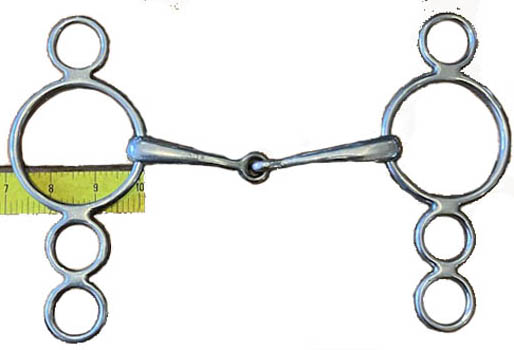
|
[Horse Bit Types] A three-ring Dutch Gag Bit is a combination snaffle and elevator-type leverage bit that is useful when control is an issue with a horse. The reins might be attached to either of the lower rings.
-
Throatlatch
[Equine Equipage] A throatlatch is a narrow strap that is part of the headstall of a bridle and runs loosely under the the horse's throat and buckles under the right ear. It prevents the bridle from slipping forward over the horse's head.
-
Throw In
[Polo] The throw in in polo is when the referee tosses the ball on the ground in front of the assembled teams. It signals the beginning of play and is also done after certain penalties.
-
Thrush
[Veterinary Medicine] Thrush is a degenerative condition of the lower portion of the horn of the hoof that may proceed to involve the entirety of the frog. It results from the hoof standing on a wet, often unsanitary, surface for a prolonged time and invasion of a multiplicity of microorganism species. The back feet are most often involved. The signs of thrush include a foul odor, a black color to the infected areas of the hoof and a tendency of the involved hoof to crumble. It will respond to treatment but the most important measure is keeping the horse on a dry and clean surface. The word thrush is used as a term for other conditions in other species, including humans.
-
Tie Down Roping (Rope and Tie-Australian and New Zealand Usage)
[Rodeo Event] Tie Down roping is a competition in which the rider ropes, dismounts and ties three of the legs of a calf. When finished the rider stands and raises his arms signaling his completion. If the calf remains secured for six seconds after this, the time is accepted. The rider with the best time wins. Rodeo rules at this point mostly preclude female competitors, but a somewhat similar event called breakaway roping is a women's event. Women are know to compete in some non-sanctioned events.
-
Tie Straps
[Equine Equipage] Tie straps dangle of off western saddles to secure some miscellaneous items the rider is carrying. There are also tie strings (saddle strings) with a similar function that are longer in length and located at the back of the saddle near the cantle.
-
Tight
[Jumping] A jump is said to be tight if the takeoff distance is too close to the obstacle
-
Time Fault
[Equestrian Competition] In timed equestrian competitions, such as show jumping and cross country eventing, riders receive penalties by coming in over an allotted time for the event. Cross country events also have time faults for completing the event in under the allotted time. In show jumping competitions the other fault is called a jumping fault and happens when a rider knocks a rail down. Often riders have otherwise similar times and it is the time fault that establishes the winner,
-
Tiludronate (Tildren®)
[Veterinary Medicine] Tiludronate is an intravenous bisphosphonate pharmaceutical, marketed by Bimeda Pharmaceuticals, for the treatment of navicular disease. It should not be used concurrently with nonsteroidal anti-inflammatory drugs, such as butazolidin. Bisphosphonates are used in human medicine for osteoporosis. I remember when navicular disease was considered a death sentence for a horse.
-
Timber Racing (Steeplechasing)
[Horse Racing] A timber race is a race over over a course of jumping obstacles. The terms timber racing and steeplechasing are both used in the United States, but steeplechasing is preferred in the United Kingdom. The riders tend to be professionals, receiving prize money and the courses demanding.
-
Tobiano
[Equine Coat Color] Paint or pinto horses are tobiano if they have a white color with dark patches.
-
Tolt (Tölt)
[Equine Gait Classification] A tolt is one of five natural gaits of Icelandic horses and is a smooth, four-beat lateral gait that can be surprisingly easy to sit to if you are lucky. The problem first time riders often have is communicating to the horse that a tolt is desired and then being able to sit to it correctly. We handle 3 gaits well, but when the horse has additional ones, just how do we signal for it? I suspect that if you get a group of Icelandic riders together that is a discussion that would go on long into the night and hopefully fueled by a lot of Brennivín. Having ridden various horses in various places, I find as a tourist you get some poor, long suffering mount that has been ruined by the inexperienced riders that it has carried. An Icelandic needs extensive schooling by limited pool of experienced riders in order to have push button gaits and that you will not find with tourist's mounts.
-
Too Far Home in the Stirrup
[Jumping] A rider whose foot is positioned too far home in the stirrup is riding with the iron back toward the heal rather than under the ball of the foot, which is the correct position. The correct position allows the rider to effectively stabilize their lower leg and stand up in the stirrups with better balance and control when called for. With experience a novice riding would sense when their foot is in the wrong place.
-
Trace
[Driving Equipage] The traces are a pair of long straps that attach the rest of the harness to the vehicle. They run from the breast collar or hames to the to the vehicle. When there is a team it attaches to a swingle bar.
-
Trakehner
[Horse Breed] Trakehners are a warm-blood breed considered the lightest and most refined of all warm-blood horses. Their breeding began in 1732 when Prussian King Frederick William I established the Trakehnen stud farm at the East Prussian town of Trakehnen. No surprise that the Prussians were interested in the military employment of the horses but they also proved themselves as winners in many international competitions in the early 20th century. The close of World War Two nearly finished the breed when East Prussia was subjugated by Soviet armies and many horses were lost. However, a small population of the horses were successfully evacuated to the west and the breed has rebounded to prewar numbers. The Germans carefully license breeding stations, maintaining the best qualities of the breed.
-
Treading-In
[Polo]
Treading-In is the replacement at half time of divots of turf that have been kicked up in the course of the game. A divot is a hoof-shaped depression with an adjacent fragment of tuff. You push the tuff over the hole and tamp it down. This is the near-sacred duty of all spectators. I would make sure you are wearing proper foot wear when you are attending a polo match. Muck boots may not go with your outfit, but you cannot easily do this in high heels either. That said, I guarantee that you will see ladies in their high heels while holding a glass of champagne joyfully stomping the ground. I think treading-in was better than a 7th inning stretch in baseball and for many may be more of a spectator sport than even the match.
-
Troika
[Sleigh Type] A troika is a traditional Russian driving combination of three horses abreast pulling a sleigh. They can reach speeds of 50 kilometers per hour (31 miles per hour). Maybe the best way to experience a troika ride in the comfort of your home is to watch the memorable scene in the movie Doctor Zhivago.
-
Transition
[Schooling] A transition is the process of a horse moving from one gait to another or making a deliberate modification of the gait it is in. The rider asks for the transitions employing standardized and specific aids for each one. Transitions require schooling of both the horse and rider so that the moves are nearly instantaneous and smooth. When watching a dressage competition the rider is using aids but they are subtle enough to be nearly imperceptible. The horse needs to understand what the aid used by the rider indicates and correctly execute it. The rider needs to time the application of the aid correctly and apply it in a consistent manner, understandable to the horse. If you have never been educated in riding, you might be surprised at all the effort expended in training the rider and the mount. It is not just a matter of getting on a horse and kicking him in the ribs and then when done pulling on his month.
-
Triple Crown
[Racing] The Triple Crown of Thoroughbred horse racing is a permanent trophy awarded to the horse that wins the three annual races conducted at the Kentucky Derby, the Preakness Stakes in Maryland and the Belmont Stakes in New York. The first historical Triple Crown winner was Sir Barton in 1919, but at that time no trophy existed.
-
Tucked Up
[Equine Posture] A tucked up horse is standing with tight abdominal muscles, a rounded back and drawn up hindlegs. The posture is an indication of significant pain and may be accompanied with other indicators as fast shallow breathing, sweating, etc. The safest thing for an owner to do in this situation is call the veterinarian for an emergency visit as soon as possible.
-
Tug (Shaft Loop)
The tug strap is seem in the center of the photo attached to the shaft.

|
[Equine Harness Equipage] A tug is a strap in a horse harness that holds the shafts of a vehicle. They attach on either side to the backband and hold up the shafts of a vehicle.
-
Turf Horse
[Racing] A turf horse is a Thoroughbred race horse that runs well on a turf tract as opposed to a dirt track. Many race tracts have side by side dirt and turf tracts and offer turf races on the daily racecard.
-
Turkoman
[Horse Breed] Turkomans are currently more a horse type than a distinctive modern breed. They were the foundation breed for the modern Akhal-Teke, who have a carefully kept studbook. They exist as a horse population type that have some of the features of the the Akhal-Teke, in the central Asia and Middle Eastern regions. Turkomans were a subtype of the earlier oriental horse type that were developed by the Turkoman tribes of Central Asia as an ideal horse for their raiding. Unlike Arabians, Turkomans had small hard hooves better for rocky terrain rather than sand and a longer back. Arabians are very short-coupled, missing a spinal vertebral segment. Turkomans have narrow bodies that dissipate heat better than a more bulky body and processed good speed and endurance.
-
Turn on the Forehand
Turn on the Forehand
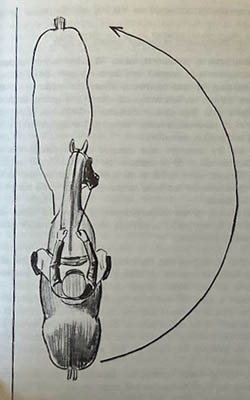
|
[Schooling] A turn on the forehand is a basic schooling or a dressage movement in which the horse pivots its body on its hindquarters while keeping its inside inside foreleg on a spot and without any forwards, sideways or backwards movement. The turn maybe a quarter turn or a half turn or really any other desired turn in practice. This is a basic lateral movement in dressage and if mastered the horse may proceed to more complex ones. In more ordinary riding it is useful in maneuvering a horse in a group of animals or in getting out of a restricted area while trail riding.
-
Turn on the Haunches
[Schooling] A turn on the haunches is a basic schooling or a dressage movement in which the horse pivots its body on its forequarters while keeping its inside hindleg on a spot and without any forwards, sideways or backwards movement.
-
Twisted Wire Snaffle Bit
Twisted Wire Full Cheek Snaffle Bit
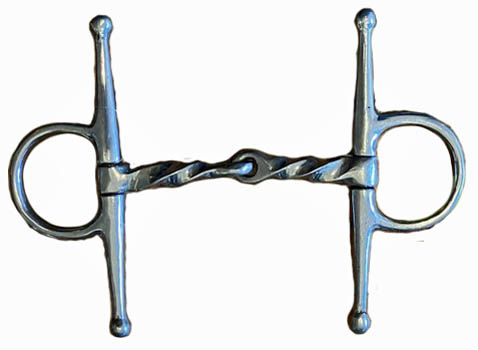
|
[Equestrian Equipage] A twisted wire snaffle bit features a unique twist to the mouth piece, forming a groove that spirals down the month piece. There are many types of these featuring various rings or curb bite styles. They all have in common the twisted month piece. In addition there is a double twisted wire snaffle, which has two narrow month pieces and is considered particularly harsh. The bit may be useful with a horse that tends to pull and respond slowly to basic bits.
-
Twitch
Chain Twitch
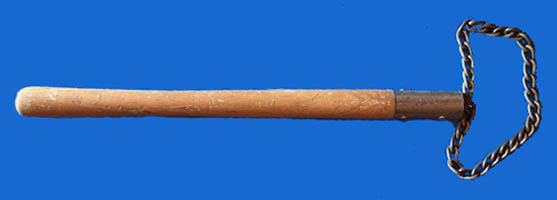
|
[Horse Equipage] A tool used to restrain and calm a horse by twisting a cord or chain around its upper lip. This is often used during some minor procedure that the horse reacts to. Although a twitch looks very medieval, when carefully placed it is more of a source of useful distraction than a cause of unbearable pain.
-
Two-Point Contact (Half Seat)
[Basic Riding] Two-point contact is when a rider rises in the saddle. There is still contact with the knees and calves on the skirt of the saddle but the seat of the rider is out of the saddle. More body weight is transferred to the heals in the stirrups and the rider usually leans forward to an appropriate degree. During a gallop and going into a jump a rider should be in two-point contact. It is also used over rough ground and going uphill.
-
Two Track Movement (Appuyer- French)
[Dressage] Two track movements are ones in which the horse moves both forward and laterally at the same time. The fore and hindlimbs track separately and parallel.
-
Tying-Up Syndrome
[Equine Veterinary Condition] The Tying-Up Syndrome is the equine form of muscle rhabdomyolysis, in which energy depleted muscle fibers breakdown and release toxic substances into the blood stream. In its most extreme form it can lead to renal failure. It tends to occur in a horse that has not been exercised recently, perhaps confined in a stall for some reason, and then pushed to perform vigorous exertion. A similar situation was been described in human military recruits who have pushed themselves too far during physical conditioning. A horse that ties up exhibits muscle stiffness and pain, sweating, blowing, trembling, reluctance to move, and has urine with a brown discoloration. The onset can be very sudden and the rider may at first think the horse is being obstinate. However, it is soon obvious that something is terribly wrong with the animal. It might occur even when lungeing a horse. If recognized and caught early the prognosis is good. A veterinarian should be called and medication may make the animal more comfortable. Hydration is also critical.
Glossary of Equestrian Terms: Main Alphabetical Listing
Links to Other Sites with Equestrian Interests
Back to Introduction
